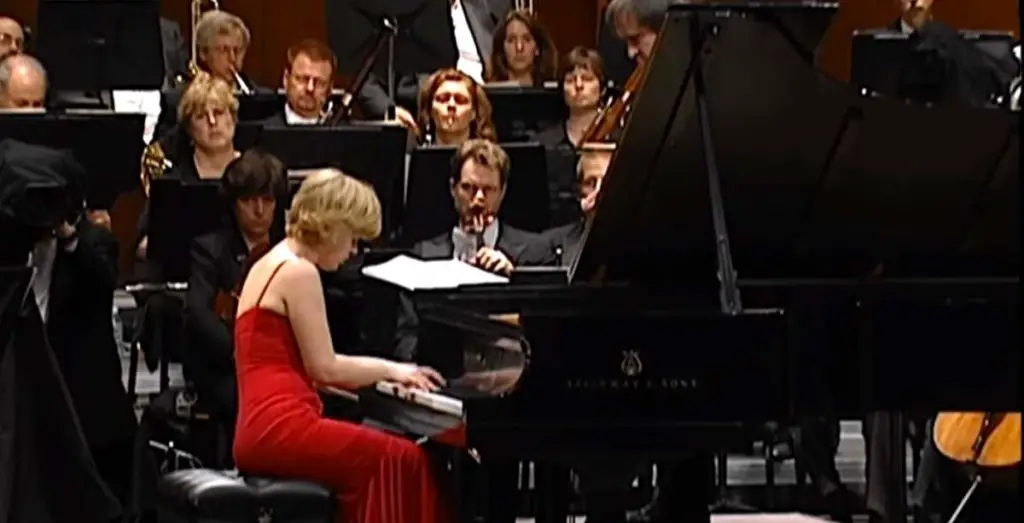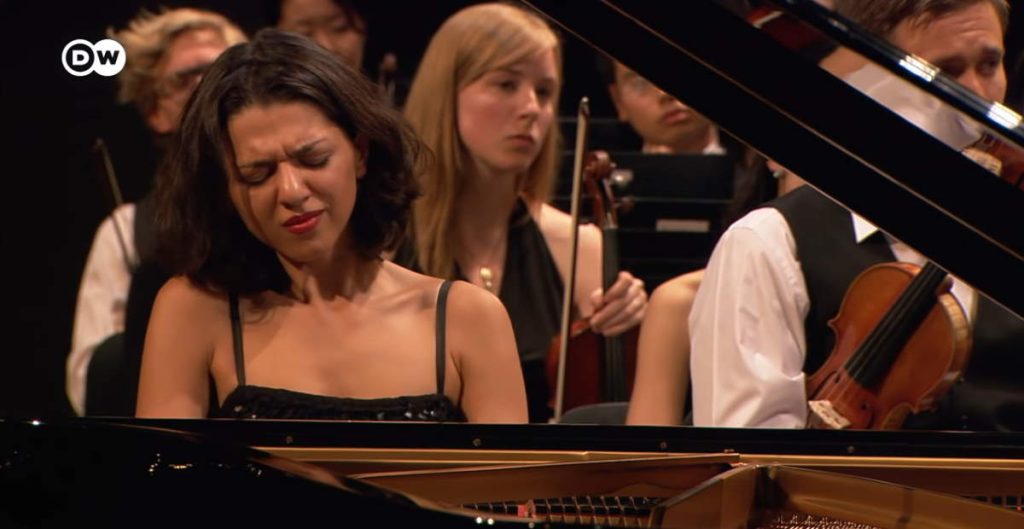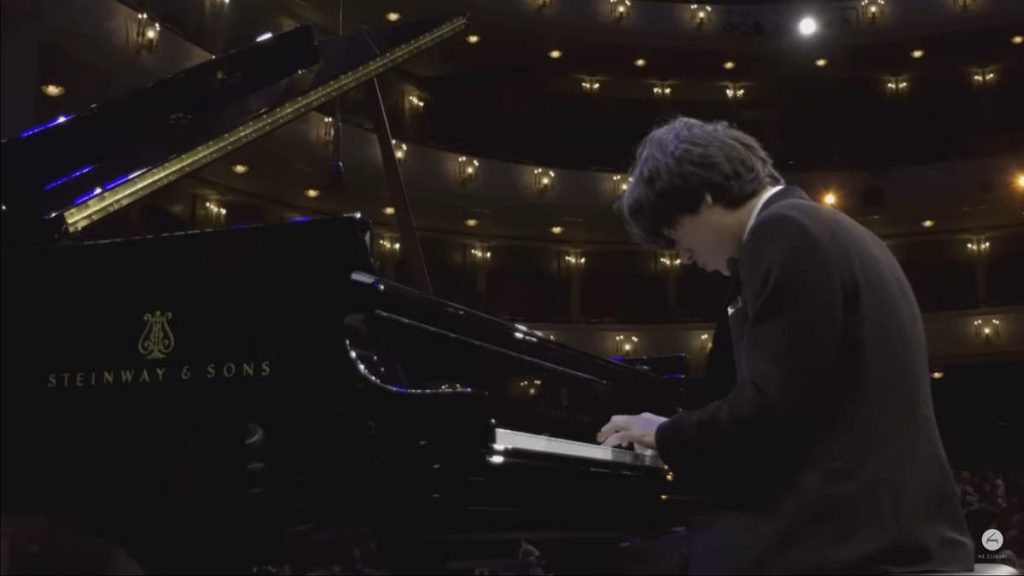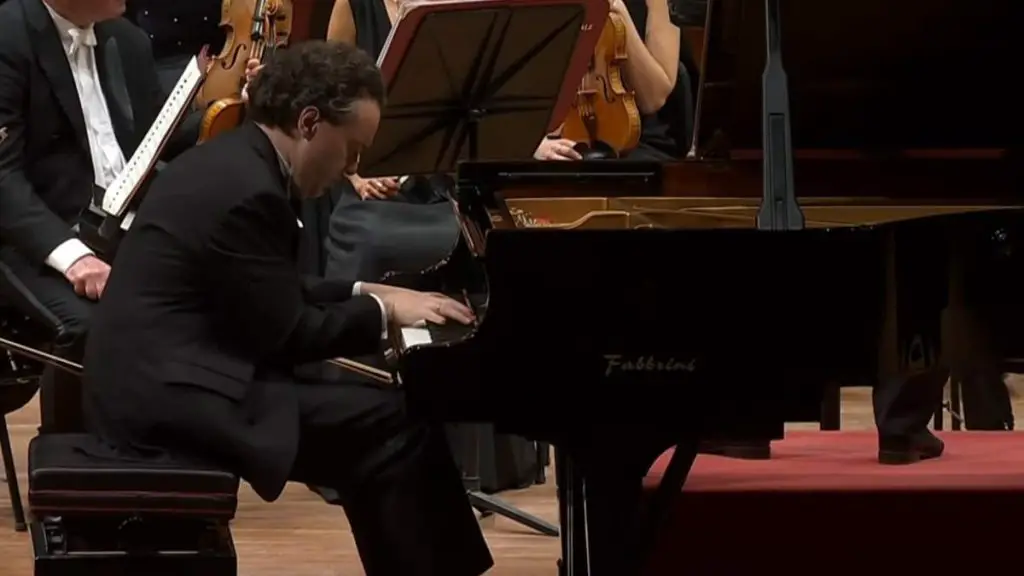Accompanied by the Fort Worth Symphony Orchestra, the Russian-born American classical pianist Olga Kern performs Sergei Rachmaninoff’s Piano Concerto No. 3 in D minor, Op. 30. Conductor: James Conlon. This performance was the final of the 2001 Van Cliburn International Piano Competition, where Olga Kern was the joint Gold Medal winner. She shared the prize with the Uzbekistani pianist Stanislav Ioudenitch. Olga Kern’s performance of the Rachmaninoff Piano Concerto No. 3 made her the first woman to achieve this honor in over 30 years.
Sergei Rachmaninoff’s Piano Concerto No. 3
Sergei Rachmaninoff’s Piano Concerto No. 3, often referred to as Rachmaninoff’s Third Concerto, stands as one of the most technically challenging and emotionally expressive pieces in the classical piano repertoire. Composed in 1909, this concerto is not only a testament to Rachmaninoff’s virtuosic skill as a pianist but also showcases his deep emotional and compositional maturity.
Born in Russia in 1873, Rachmaninoff was a pianist, composer, and conductor, known for his profound melodies and intricate piano techniques. His Third Piano Concerto was written during a time of transition in his life, shortly before he left Russia to tour the United States. This period was marked by a mix of excitement and uncertainty, emotions that are profoundly reflected in the concerto’s expressive depth.
The concerto is renowned for its technical demands, often regarded as one of the most challenging pieces to perform in the piano repertoire. It requires not only exceptional technical skill but also immense stamina and emotional depth from the performer. The piece is characterized by its wide-ranging piano techniques, including rapid finger passages, complex rhythms, and the use of the entire range of the keyboard, demanding a high level of precision and dexterity.
Beyond its technical aspects, Rachmaninoff’s Third Concerto is celebrated for its rich, lyrical melodies and deep emotional expression. The concerto is imbued with a sense of romanticism, yet it also reflects the composer’s introspective and sometimes melancholic style. This blend of technical prowess and expressive depth has made the piece a favorite among audiences and a significant challenge for pianists.
Rachmaninoff himself premiered the concerto in New York City in 1909, with Walter Damrosch conducting the New York Symphony Society. The concerto did not achieve immediate success and was initially met with mixed reviews. However, over time, it gained recognition and popularity, becoming one of Rachmaninoff’s most famous and enduring works.
The concerto’s emotional range, combined with its technical challenges, makes it a staple of the concert repertoire and a defining piece in the career of many pianists. Its enduring appeal lies in its ability to convey deep emotions while showcasing the pianist’s virtuosic abilities, making it a celebrated masterpiece in the world of classical music.
The concerto is one of the main foci of the 1996 film Shine, based on the life of pianist David Helfgott.
Movements
There are three movements. With start times in the video:
- Allegro ma non tanto 0:00
- Intermezzo: Adagio 17:40
- Finale: Alla breve 28:09
1. Allegro ma non tanto
The first movement of Sergei Rachmaninoff’s Piano Concerto No. 3 is a compelling blend of lyrical expressiveness and complex musical structures. Officially titled “Allegro ma non tanto,” this movement sets the stage for the entire concerto with its dramatic intensity and technical sophistication.
The movement opens with a soft, haunting melody played by the piano. This theme, simple yet profoundly evocative, serves as a foundation for much of the movement’s development. Rachmaninoff’s ability to weave a single melody into various emotional and textural fabrics is immediately evident. The opening melody, while initially delicate and introspective, undergoes transformations throughout the movement, reflecting different moods and intensities.
As the orchestra joins in, the music gradually builds in intensity. Rachmaninoff’s orchestration is masterful, with the orchestra not merely accompanying but actively dialoguing with the piano. The interplay between the solo piano and the orchestra is a key feature of this movement, showcasing Rachmaninoff’s skill in balancing soloistic brilliance with orchestral color.
The movement is structured in a modified sonata form, a common structure in classical concerto movements, where themes are presented, developed, and then recapitulated. However, Rachmaninoff’s approach to this form is anything but conventional. He introduces a variety of themes and motifs, each rich in emotional content, and weaves them together in a tapestry of sound that is both complex and accessible.
One of the most remarkable aspects of the first movement is its technical demands on the pianist. It requires not only virtuosic fingerwork and stamina but also a deep understanding of the music’s emotional depth. The pianist must navigate through rapid, intricate passages, wide leaps, and demanding rhythms, all while maintaining musical expressiveness and sensitivity to the orchestral accompaniment.
The movement’s climax is both emotionally charged and technically challenging, featuring a cascade of notes from the piano, supported by the full power of the orchestra. This leads to a resolution that is both satisfying and reflective, setting the stage for the concerto’s subsequent movements.
2. Intermezzo: Adagio
The second movement of Sergei Rachmaninoff’s Piano Concerto No. 3, marked “Intermezzo: Adagio,” provides a striking contrast to the first movement’s complex and intense character. This movement is more introspective and lyrical, showcasing Rachmaninoff’s ability to create deeply emotional and expressive music.
The movement opens with a serene and somewhat melancholic theme introduced by the orchestra. This theme sets a mood of contemplation and introspection, a common characteristic of Rachmaninoff’s slower movements. The piano enters gently, intertwining with the orchestra’s theme and adding layers of emotional depth. The interaction between the piano and the orchestra in this movement is less about virtuosic display and more about creating a rich, emotional tapestry.
The Adagio is structured in a simple ternary form (ABA), with the central section providing contrast to the opening and closing sections. This central section brings a slight increase in tempo and intensity, introducing new thematic material that adds a sense of drama and urgency. However, this is not the passionate drama of the first movement but a more restrained, introspective kind of intensity.
Rachmaninoff’s use of harmony in this movement is particularly noteworthy. He employs lush, romantic harmonies that create a sense of warmth and depth. The piano part, while not as technically demanding as in the first movement, requires a high degree of sensitivity and expressiveness. The pianist must convey the nuances of the music, bringing out the underlying emotions without overwhelming the delicate balance of the movement.
The movement concludes with a return to the opening theme, but this time it’s imbued with a sense of resolution and peace. The piano and orchestra gently bring the movement to a close, creating a sense of closure that is both emotionally satisfying and reflective.
3. Finale: Alla breve
The finale of Sergei Rachmaninoff’s Piano Concerto No. 3 is a brilliant and exhilarating finale that combines virtuosic piano writing with lush orchestration. Marked “Finale: Alla breve,” this movement is known for its energetic rhythm, complex structures, and the dramatic interplay between the piano and the orchestra.
This movement begins without a pause from the second, creating a seamless transition that maintains the concerto’s overall continuity. The opening is characterized by a rhythmic, vigorous theme introduced by the piano, immediately setting a tone of excitement and dynamism. This theme, with its driving rhythm and bold character, forms the backbone of the movement.
Rachmaninoff’s skill as a composer and pianist is particularly evident in this movement. The piano part is replete with technical challenges: rapid fingerwork, intricate passagework, and demanding leaps. The pianist must display not only technical prowess but also the stamina to sustain the movement’s relentless energy.
The orchestra plays a crucial role in this movement, providing both support and contrast to the piano. The interplay between the piano and orchestra is intricate and intense, with the orchestra echoing, complementing, and sometimes competing with the piano. Rachmaninoff’s orchestration is masterful, balancing the power of the piano with the full force of the orchestra.
The structure of the movement is complex, with multiple themes and motifs interwoven throughout. Rachmaninoff employs a modified sonata form, allowing for thematic development and variation. This structure, combined with the rhythmic vitality and thematic richness of the movement, creates a sense of forward momentum and excitement.
One of the most remarkable aspects of this finale is its culmination in a grandiose and technically demanding cadenza. The pianist has the option to choose between two different cadenzas Rachmaninoff wrote for this concerto – one that is more lyrical and expansive, and another that is more concise and technically challenging. Both cadenzas require exceptional skill and serve as a showcase for the pianist’s abilities.
The movement concludes with a return to the opening theme, leading to a thrilling and triumphant climax. The final chords, played by both the piano and the orchestra, bring the concerto to a powerful and exhilarating close.
Olga Kern
Olga Kern (born April 23, 1975, Moscow) is a Russian classical pianist who now lives in New York. She was the first woman in over 30 years to receive the Nancy Lee and Perry R. Bass Gold Medal in the Eleventh Van Cliburn International Piano Competition, tying for first with Stanislav Ioudenitch.
Kern has given solo recitals and appeared in concert at Carnegie Hall, Lincoln Center, Avery Fisher Hall, the Hollywood Bowl, the Great Hall of the Moscow Conservatory, London’s Royal Albert Hall, Symphony Hall in Osaka, the Salzburger Festspielhaus, Milan’s Teatro alla Scala, Zurich’s Tonhalle, the Théâtre du Châtelet in Paris, Munich’s Gasteig, and the Tonhalle Düsseldorf. the Laeiszhalle in Hamburg, the Milan Conservatory “Giuseppe Verdi,” the Teatro Comunale di Bologna, the Rudolfinum in Prague, Cadogan Hall in London, Edinburgh’s Usher Hall, Glasgow Royal Concert Hall, the Grande Auditorio Culturgest in Lisbon, and Madrid’s National Auditorium of Music.

Sources
- Piano Concerto No. 3 (Rachmaninoff) on Wikipedia
- Olga Kern on Wikipedia
- Eleventh Van Cliburn International Piano Competition Winners on the Van Cliburn International Piano Competition’s official website
- Chopin: Scherzo No. 3 [İlyun Bürkev] - September 14, 2024
- César Franck: Violin Sonata [Argerich, Capuçon] - September 8, 2024
- Beethoven: Piano Sonata No. 23 “Appassionata” [Anna Fedorova] - September 7, 2024



